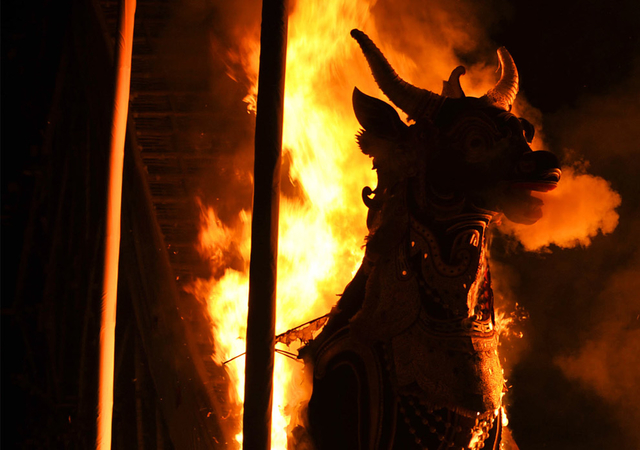
An animated crowd fills the streets. People are shouting, laughing, and smiling. Men carry bamboo platforms with towering towers and statues of animals on their shoulders. The statues spin and sway. A long white strip of fabric flows through the crowd. The procession heads towards the temple, where the space is already decorated and prepared for the ceremony.
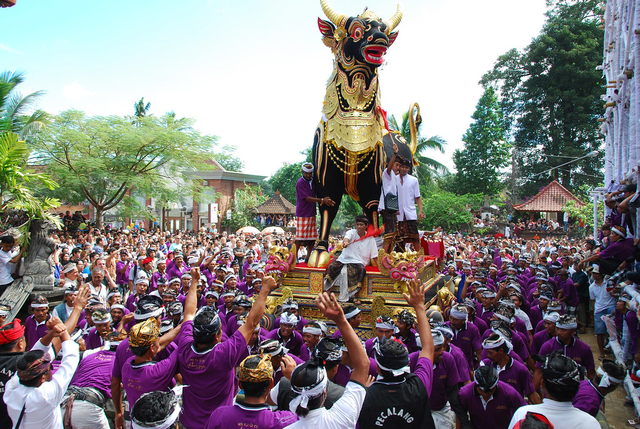
After spinning several times, the carriers of monumental structures place them on the ground. The backs of the animal figures open, and curious onlookers gather around. A white bundle descends from the tower and is placed into a sarcophagus shaped like an animal, along with fabric and offerings. Flames are lit, engulfing the figurine of the symbolic animal in a purifying fire, which is sacred to the Balinese.
This is just one of the rituals in the chain of Balinese funerals. However, it is the most important and solemn one. Balinese cremation is a grand ritual that raises many questions for the uninitiated:
- Do they cremate or bury the deceased in Bali?
- Why do all Balinese people seem joyful at funerals and nobody cries?
- What is the purpose of the animal figures, and why are they often made in the form of bulls and cows?
- Where do they scatter the ashes afterward?
Cremation is one of the final stages in the transformation and passage of the deceased to another world. Sometimes, the preparation for this ritual takes several days, months, or even years.
In Balinese culture, the human body is just a temporary shell, a container for the soul, connecting it to earthly life. During funeral rituals, the main focus is on the soul of the deceased and their journey to the heavens. Instead of grieving, Balinese people consider it appropriate to celebrate, marking the imminent reunion of the departed with God.
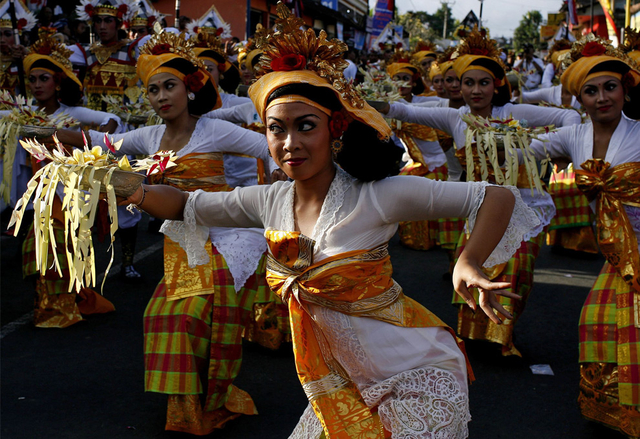
In Balinese cosmology, the human body is considered a microcosm, a reflection of the Universe, the macrocosm. Like the Universe, it is composed of five elements - water, earth, fire, air, and space, serving as a temporary abode for the atman, the immortal soul.
After the body dies, following the principle of Samsara or reincarnation, the soul must find refuge in another form. Before this reincarnation, it goes either to hell (neraka) or to heaven (suarga), or the soul, having completed the cycle of rebirths, achieves final unity with God (moksha).
Balinese people believe that the soul of a recently deceased person cannot immediately leave the body. In the form of a ghost, it may wander around and even disturb family members.
Only after the body's constituent elements return to the macrocosm, the soul can be liberated and move on. The ceremony associated with the return of the elements to the macrocosm is called "pengabenan" in Bali, often referred to shortly as "ngaben." The word "ngaben" originated from "abu," meaning ashes. In the formal Balinese language, this ceremony is called "pelebonan," or shortly "pelebon."
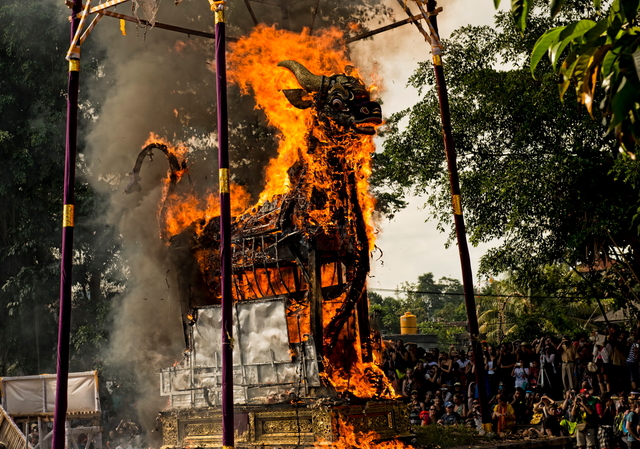
But actually, cremation is just the culmination of "ngaben."
Balinese people believe that one should not skimp on funeral expenses because after death, the soul of the deceased family member can become a sacred protector, endowed with the power to help or punish. Therefore, a cheap burial ceremony is not the best way to establish a relationship with one's protector.
However, not only the spirits will be impressed by a grand cremation. A well-organized ceremony also helps to strengthen the family's status in the village. That's why relatives make every effort to arrange the most significant event possible.
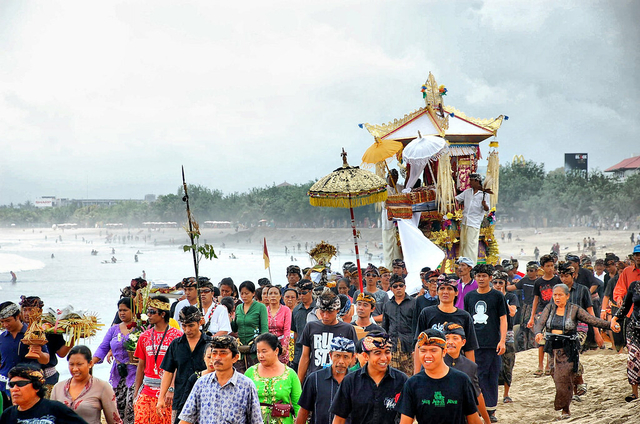
The event can cost a pretty penny because a large ceremony may require the efforts of dozens or even hundreds of people and a considerable amount of time.
The family organizing the "ngaben" is not just close relatives. It includes cousins, uncles, aunts, in-laws, children, and grandchildren. All these people are involved in the ceremony, dedicating a significant portion of their time or even canceling their usual tasks to prepare for the ritual.
The higher a person's caste, the more elaborate the "ngaben" is expected to be. Sometimes, it's not that simple, as social status is not always automatically linked to financial prosperity.
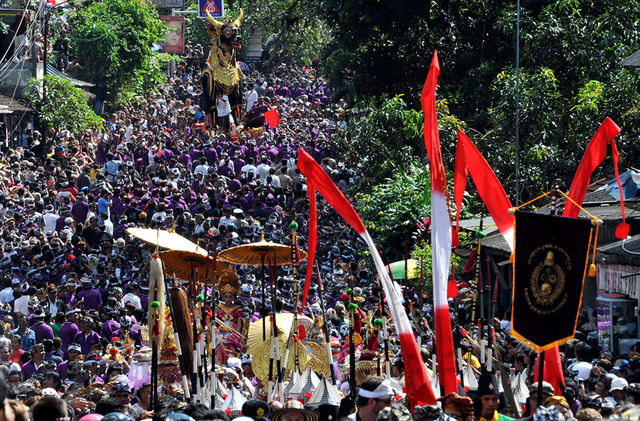
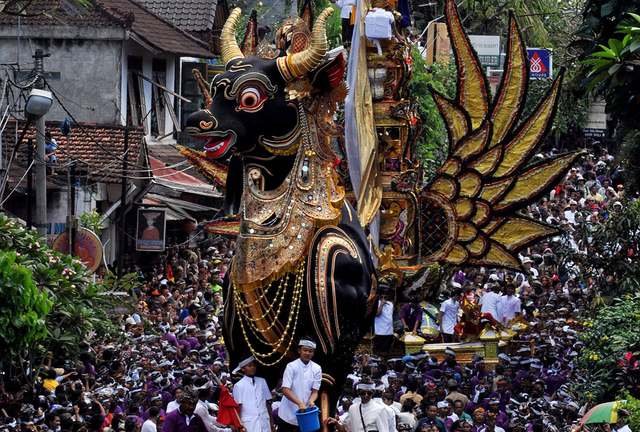
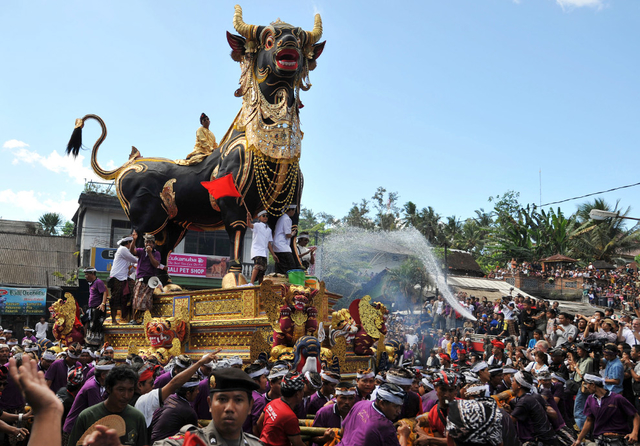
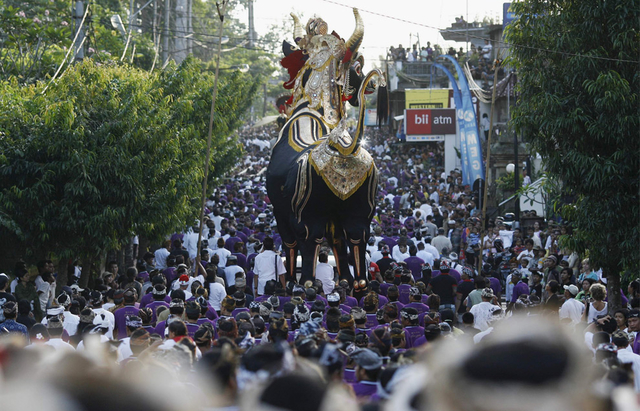
"Less affluent Balinese people hold a simple ceremony, burying the body temporarily in a cemetery. Then, when they have enough money saved, they eventually conduct a cremation that they can be proud of.
Sometimes, less wealthy Balinese individuals ask wealthier ones for the opportunity to join a larger cremation to save on costs."
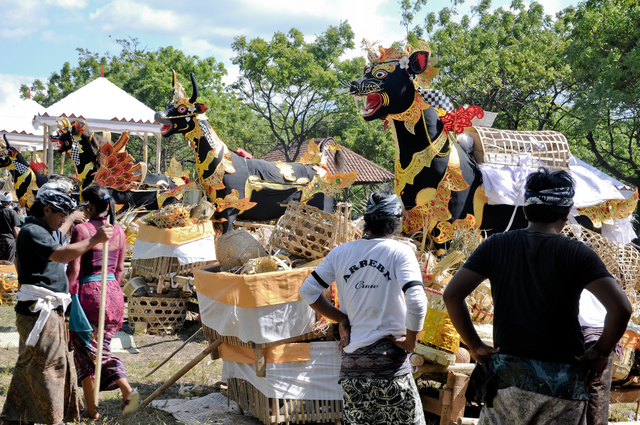
Sometimes on Bali, collective ceremonies of mass cremation take place, where the remains of dozens or hundreds of deceased individuals can be cremated. Occasionally, the time between the actual death and the cremation can span several years. Balinese people believe that during this time, the soul of the deceased may trouble their relatives, so they try to cremate the deceased as quickly as possible.
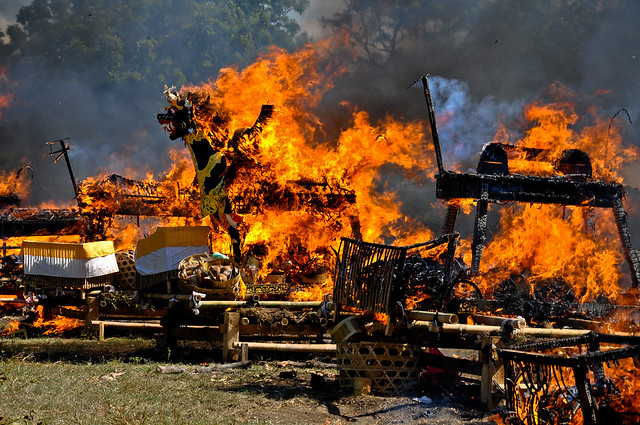
If a priest or a representative of a noble family passes away, it is considered unacceptable to bury them in the ground. The body is preserved and kept in a pavilion at the family home, awaiting the ceremony. During this time, daily offerings, including symbolic food as if it were served to the living, prayers, and round-the-clock supervision of the body are conducted.
It is not always possible to organize cremation quickly, even if the funds allow it. The reason is that such significant events follow the Balinese ceremonial calendar called "pawukon," which marks auspicious and inauspicious days for various activities. The pawukon covers actions such as traveling to the south and north, rice harvesting, garbage burning, house construction, market visits, weddings, tree cutting, and, of course, cremations.
For large-scale cremations, special bamboo structures are built, including a cremation tower, a ladder to it, and pavilions for the cremation. Several days may be required for bamboo cutting. During these days, offerings will also be made as part of the cremation preparation. Some offerings are simple, while others may include a significant amount of food, including duck and pork.
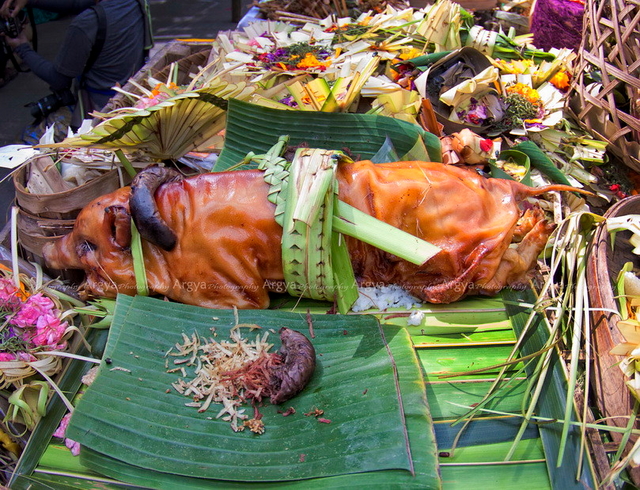
Offerings are made to invoke the favor of gods and spirits, appease them, including both benevolent and malevolent ones, as the malevolent spirits may eagerly roam around, waiting for any opportunity to interfere with the ceremony and human activities.
Most importantly, offerings serve as a way to address the supreme god with a request to purify the soul of the deceased and return it to the earth in its purest and highest form.
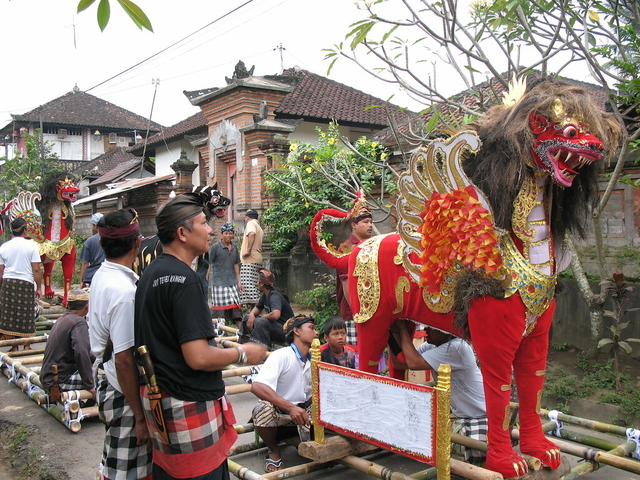
In every large-scale cremation ceremony, a sarcophagus in the shape of an animal is used to burn the remains. Sarcophagi for the higher castes of Balinese people are called "lembu." They are crafted in the form of a bull for men and a cow for women. For lower castes, sarcophagi in the shape of a lion, deer, or fish-elephant called "gajah mina" can be used.
In any case, the figure must stand on four legs, symbolizing the four spiritual brothers of a person who accompany them from birth to death.
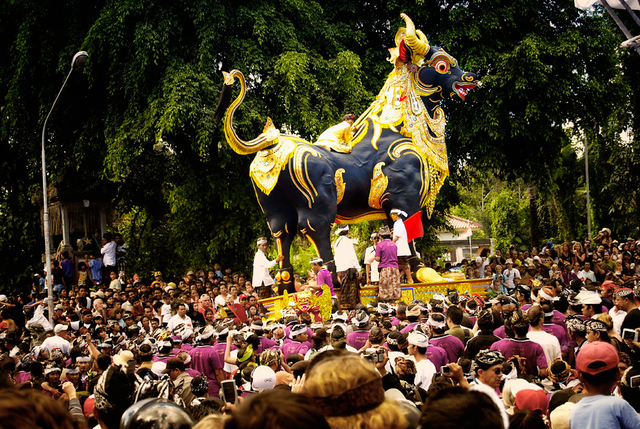
The most revered form of a sarcophagus is that of a bull. According to mythology, the bull was harnessed to the chariot of the god Shiva, who symbolizes death, destruction, and the rebirth of the spirit.
Sarcophagi are typically made to be the size of the original animal, but they can be even larger. They are covered with fabric, often black for bulls, and yellow or white for cows.
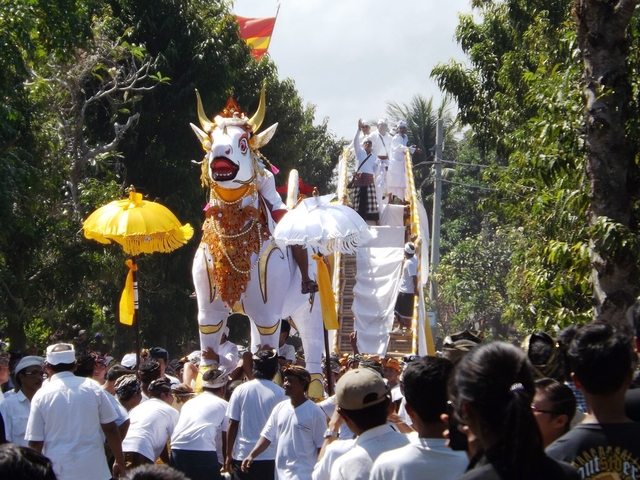
These figures are also adorned with intricate patterns, mirror mosaics, glitters, and various other decorations. Then, such a sarcophagus is secured onto a bamboo platform, which the Balinese people will carry on their shoulders.
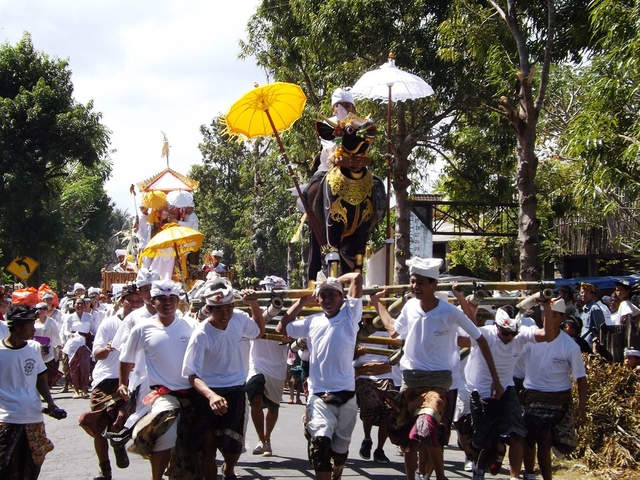
Another grand structure for cremation is the cremation tower, known as "wadah" or "bade." Such a tower symbolizes the Balinese Universe.
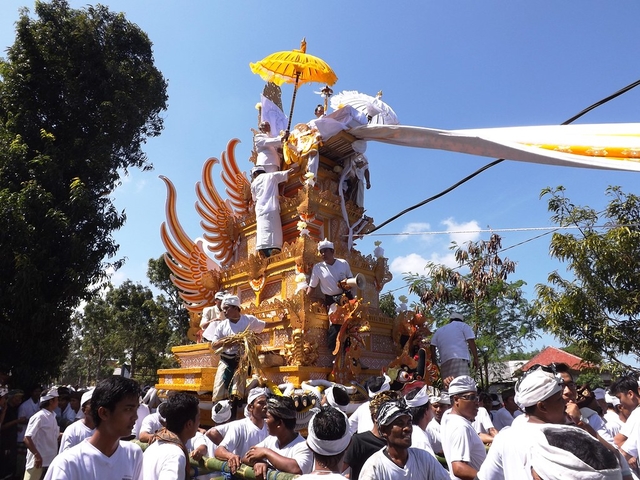
At its base, there is the symbol of the cosmic turtle, representing the foundation of the world - Bedawang Nala, surrounded by two snakes, Nagas - Nagabasuki and Naga Anantaboga.
The turtle and the Nagas reside in the lower world, Bhur. They reflect the basic needs of human life - safety, food, clothing, and shelter. Each person is accompanied by these two Nagas as a microcosm, but they become unnecessary after death. Sometimes, towers of very important caste representatives are adorned with another snake-naga, Nagabanda.
Next is the middle world - the world of humans, Bhuvah or Bwah. It is represented in the tower by symbols of forests and mountains.
Then comes a tier symbolizing a house or pavilion - supported by four pillars, representing the four spiritual brothers of a person. It is in this part that the remains of the deceased Balinese are transported as the procession leads to the designated cremation site.
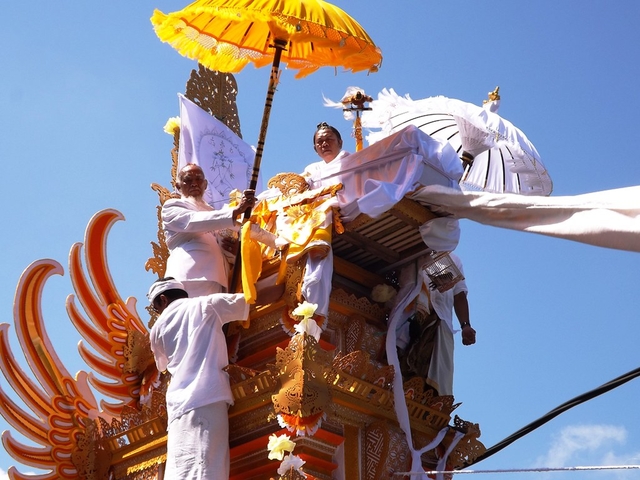
However, remains can be placed inside the tower only if they were not previously buried in the ground. If they were buried, an image of the deceased is placed on this tier.
At the very top of the tower are the symbolic heavens - "swah." They are often depicted as multiple tiers or several rows of diminishing-sized roofs. Similar designs can be seen on Balinese temples. These tiers symbolize the 11 levels of heavens and the cosmic mountain - Mount Meru. Only royal towers can have 11 tiers, while less prominent castes settle for nine or seven tiers.
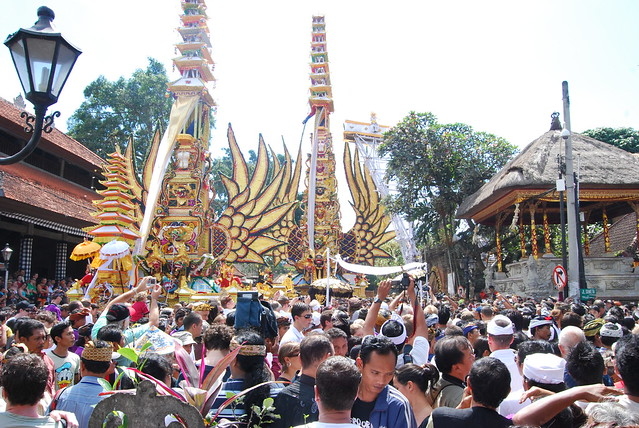
On the backside of the tower, a mask of the monstrous creature Bhoma can be placed. It has a fanged face, which can also be found on Balinese temples, serving the purpose of warding off evil spirits.
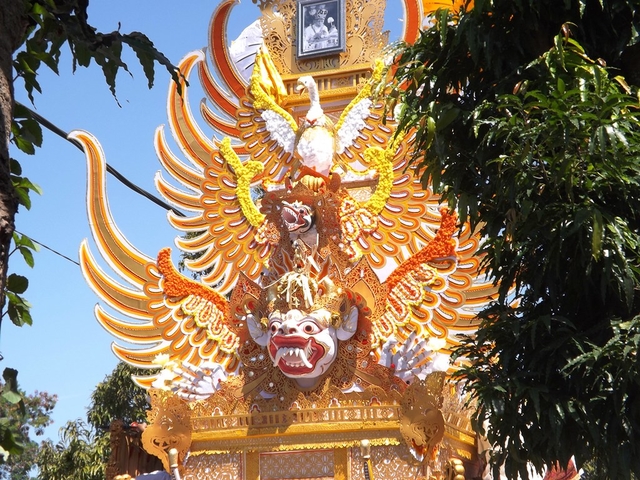
The height of the cremation tower is limited not only by the family's budget but also by logistical challenges. During the funeral procession, as the tower is carried through the streets, it may encounter obstacles such as overhead wires. To address this, Balinese individuals with long bamboo T-shaped poles accompany the procession and lift the wires in front of the tower.
The height of the cremation tower for particularly prominent Balinese individuals can range from 10 to 20 meters or even exceed that. These structures are usually custom-made by specialized artisans.
Along the procession route, a long white cloth called "lachinan" stretches, attached at one end to the cremation tower. It holds a special ceremonial significance as not all participants can physically carry the cremation tower, so the cloth symbolizes their participation in the process.
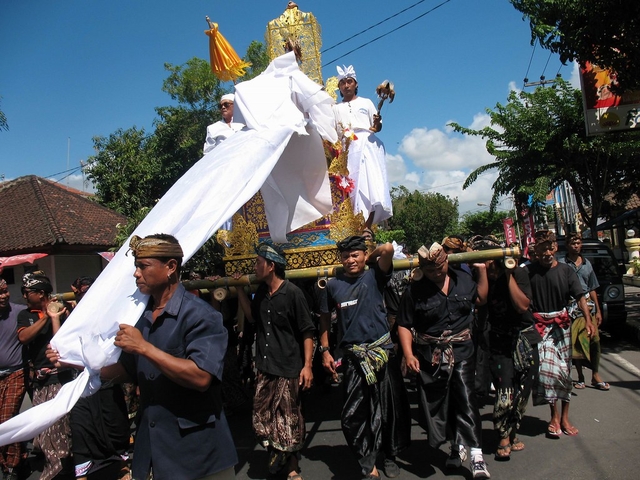
If the body was temporarily buried before cremation, the remains are exhumed, cleansed, wrapped in white cloth, and placed in a temporary shrine at the cemetery. The ashes of the deceased are never brought back home, and household ceremonies are conducted without the involvement of the remains.
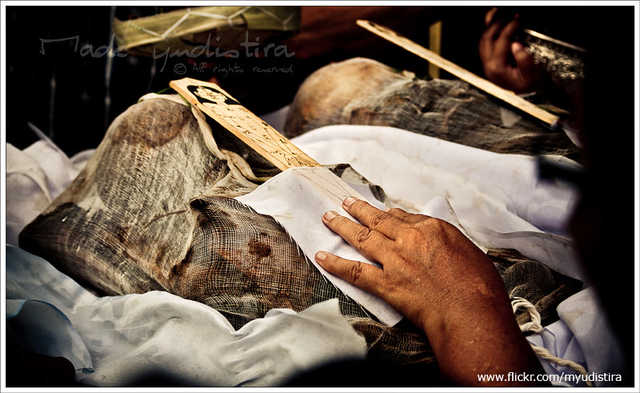
Crowds of Balinese people begin to gather for the cremation in the morning. Quite often, the ceremony takes place around noon. All members of the "banjar" - the community of villagers, are obliged to attend the event. It is difficult to predict the exact time of the procession and the cremation in advance. So, if you decide to come and witness the "ngaben" ceremony, arrive early in the morning and enjoy the vibrant atmosphere.
Nobody cries or mourns. Firstly, the soul will soon embark on its journey to heaven, the most desirable place. Secondly, Balinese believe that crying during a funeral will disturb the soul and make it harder for it to leave this world.
At the front of the procession, sarcophagi in which the ashes will be cremated are usually carried. Following them, a group of Balinese men and women bear offerings while dressed in splendid traditional costumes.
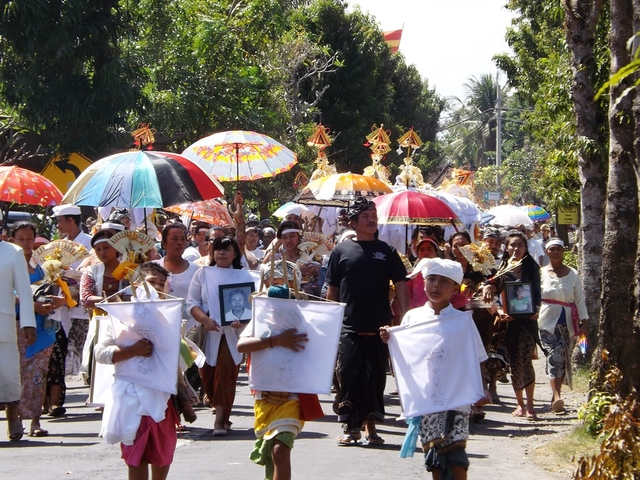
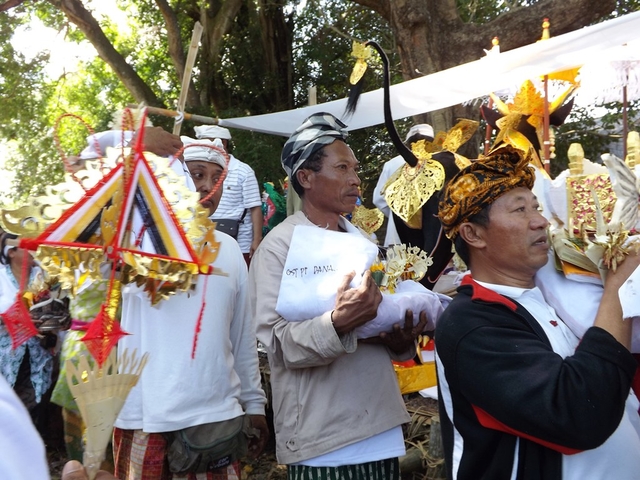
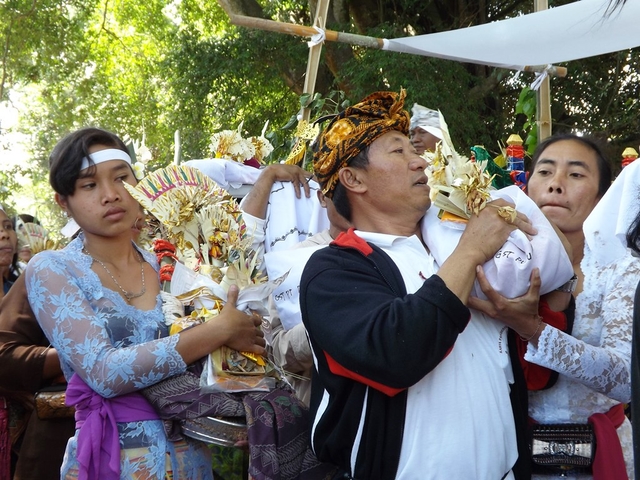
The cremation tower concludes the procession. Beside it, prominent members of the deceased's family may carry them on a palanquin.
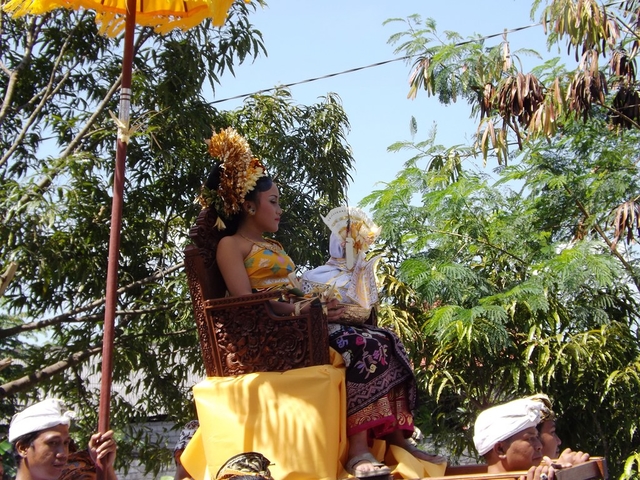
The cremation takes place near the Pura Dalem temple in the local village. Every village has a temple of this kind dedicated to Lord Shiva as the destroyer and transformer. Depending on the distance of the route, the procession time can be around an hour or more.
This location is situated away from the village, facing the ocean, and therefore considered less pure.
Upon arrival, the sarcophagi are placed in special pavilions or shelters under white roofs, symbolizing the sky.
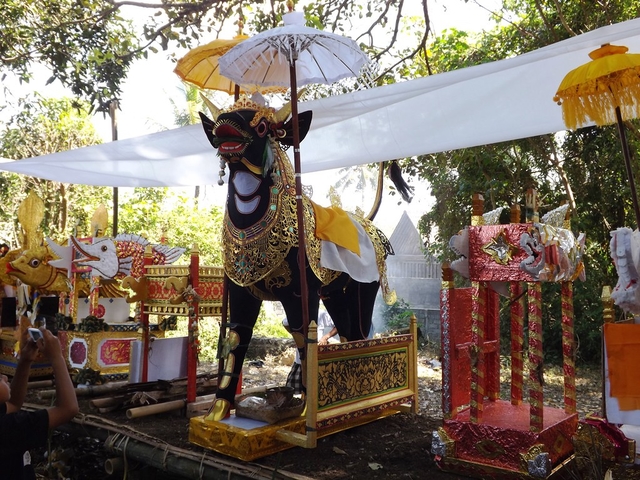
It is customary to make three counterclockwise circles around the pavilions before continuing the ceremony.
Family members of the deceased open the top part of the sarcophagi. Here, they place the body of the deceased, wrapped in white cloth, or the remains that were previously buried at the cemetery and prepared for cremation.
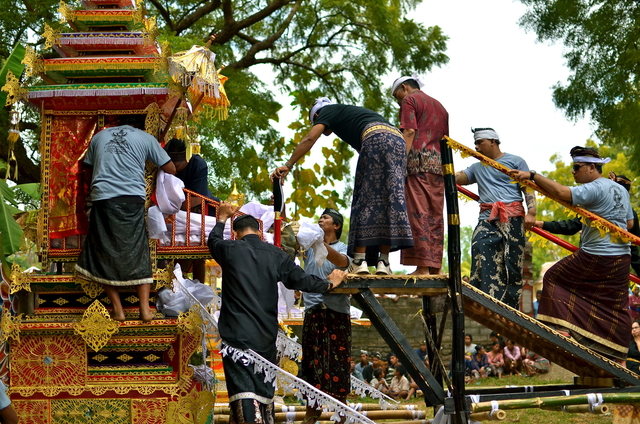
Inside the sarcophagus, offerings are placed, and holy water is poured before closing the sarcophagi back.
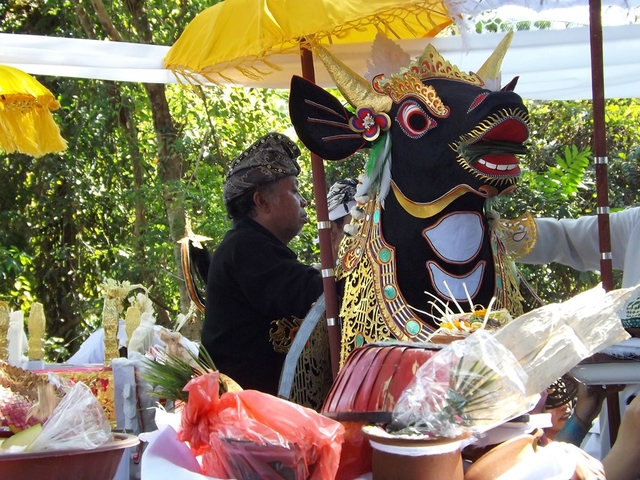
In modern times, gas burners are commonly used instead of firewood for kindling the fire.
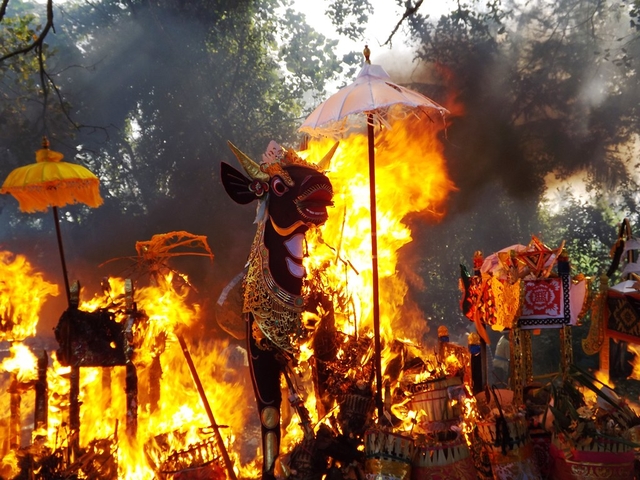
Usually, the priest ignites the fire. The cremation tower and all other structures prepared for the ritual are burned separately.
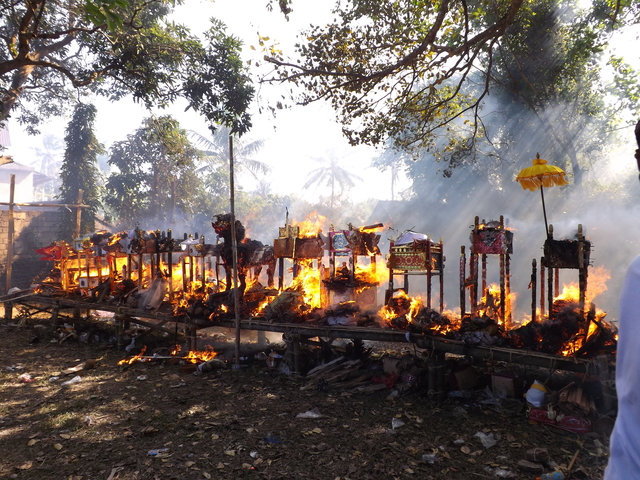
Sometimes, the sarcophagus may not fully burn, and the partially unburnt body of the deceased falls out of it. In such cases, the Balinese people who are overseeing the burning process simply push it back into the flames to ensure complete cremation.
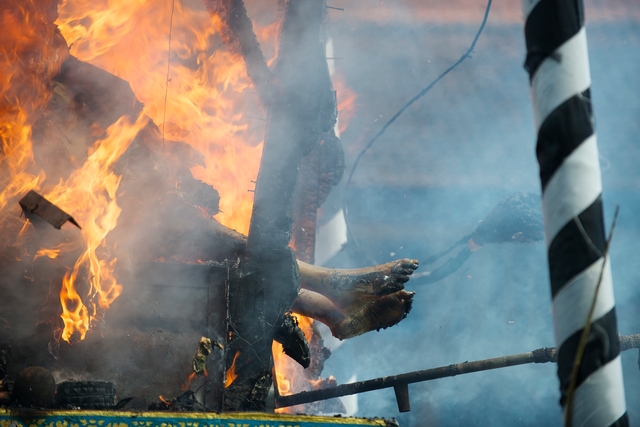
When the cremation is complete, the ashes are sprinkled with holy water.
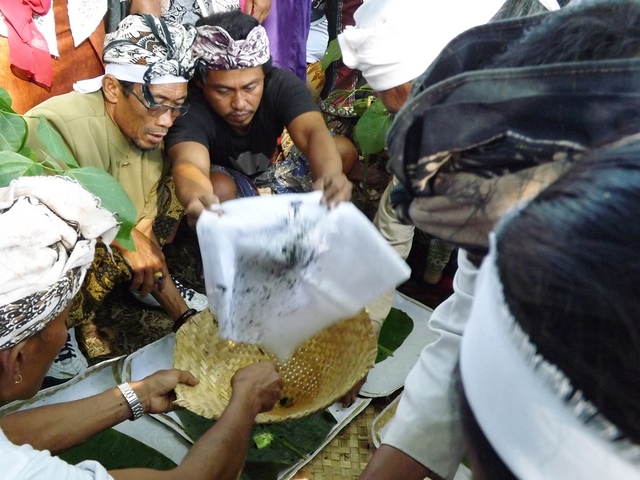
The fragments of the deceased's body and ashes are placed inside a ceremonial yellow coconut. The priest recites prayers while ringing a small bell, intending to ease the journey of the soul to the afterlife and help it on its way to heaven.
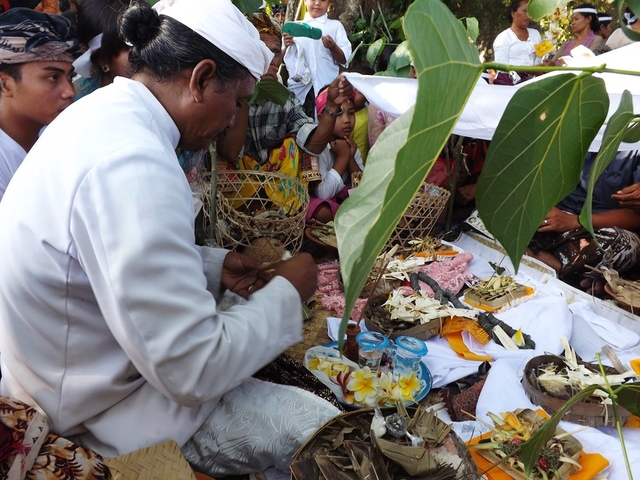
After a few days, usually around 12 days later, the procession sets off with the remains in the coconut to the ocean's shore, or if the coast is too far, to a river. Although the sea or ocean coast is considered more preferable for the "nganyut" ceremony. The remains can be taken far out to the sea on a boat to avoid washing up on the beach anytime soon.
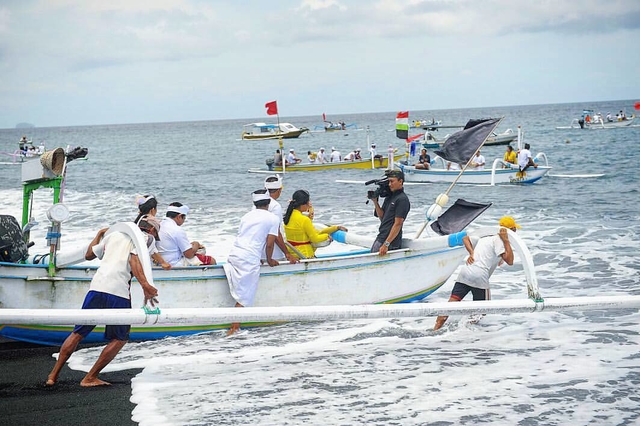
Balinese people believe that now the five elements that composed a human body have returned to the macrocosm from which they came. The soul has been released into the sea, and all its imperfections will settle at the bottom like sediment, while the purified and beautiful soul will ascend to heaven.
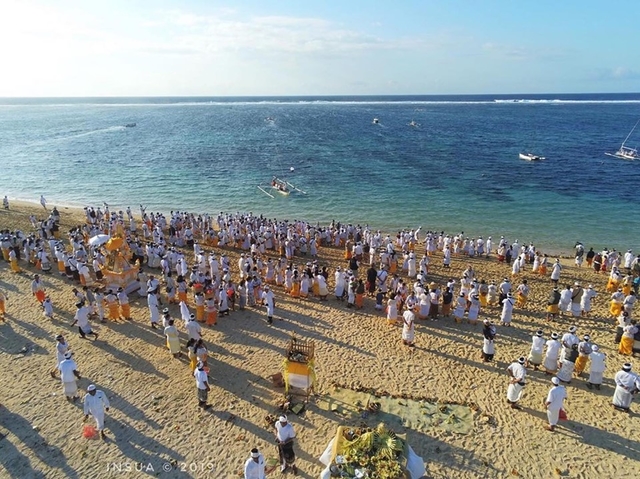
The ceremonies don't end there. After all, it is necessary to express gratitude with gifts to family members and the community who participated in the ritual. They visit temples to make offerings to the gods in gratitude for the proper ceremony. Most importantly, a ritual is conducted in honor of the deified ancestor in the family's home temple, who will now await the next reincarnation.
And only after all this, they can finally rest.
You can add one right now!